Top Project Management Tools for Small Teams in 2025

Juggling deadlines, tracking progress, and ensuring clear communication can feel like a full-time job in itself, especially for small teams where everyone wears multiple hats. The right digital platform can transform this chaos into a streamlined, efficient workflow, but sifting through the countless options is a project in its own right. This guide is designed to cut through the noise, providing a comprehensive analysis of the best project management tools for small teams available today. We move beyond generic feature lists to give you practical, real-world insights into how each tool actually performs.
This resource will help you make an informed decision by breaking down the top contenders, from comprehensive suites like Asana and ClickUp to niche solutions like Obsibrain, which is ideal for Obsidian users seeking to integrate structured planning directly into their knowledge management system. For each platform, we offer a detailed review that includes:
Honest pros and cons based on real user experiences.
Specific use-case scenarios to help you visualize the tool in your workflow.
Clear pricing breakdowns so you understand the total cost of ownership.
Implementation guidance and screenshots to see the interface in action.
Our goal is to equip you with the knowledge to select a tool that not only organizes your tasks but also enhances your team's unique collaborative style. If your team is operating on a limited budget or just starting out, exploring the 12 Best Free Task Management Tools for Teams can be a great preliminary step before committing to a paid solution. Now, let’s dive into the detailed comparisons to find the perfect fit for your team.
1. Obsibrain
Obsibrain presents a unique and powerful paradigm for project management, particularly for small teams already invested in or open to adopting the Obsidian ecosystem. Instead of a standalone cloud-based service, it operates as a comprehensive, science-backed template within the Obsidian application. This turns your private, offline-first note-taking environment into a centralized command center for all team activities, consolidating tasks, notes, and strategic goals into one unified vault.
For small teams, this integrated approach eliminates the friction and cost of juggling multiple applications. Obsibrain leverages proven methodologies like the P.A.R.A. folder system and SMART project frameworks, providing a structured yet flexible foundation. This design ensures that every meeting note, task, and project document is interconnected and aligned with your team’s core objectives, making it one of the most cohesive project management tools for small teams who value data ownership and deep work.
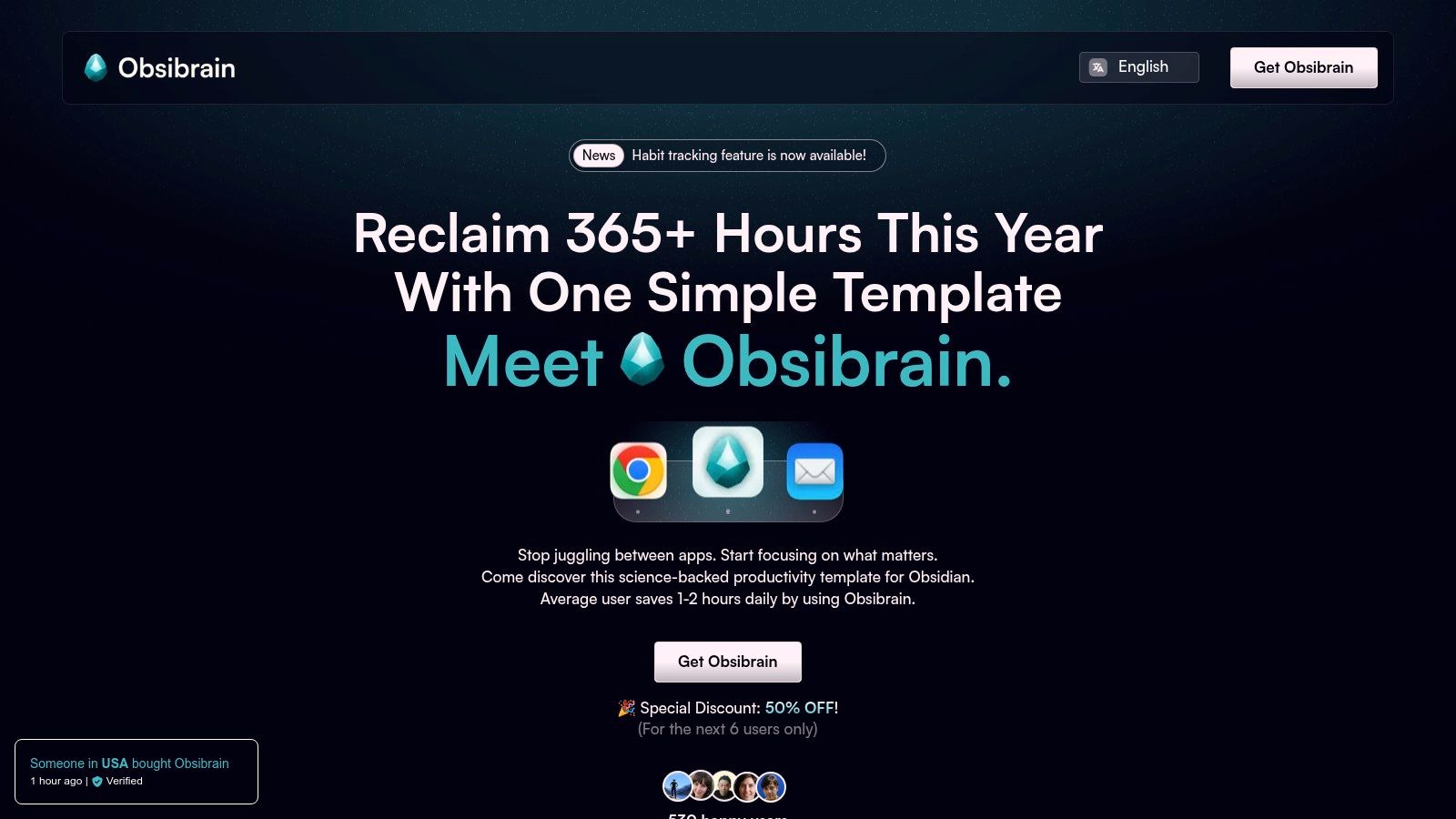
Key Features & Use Cases
SMART Project Framework: Each project is set up with clear, actionable goals. This is ideal for a small marketing team launching a new campaign, where every task from content creation to ad placement can be linked directly to the overarching project goal within the same system.
Centralized Task Management: The system integrates tasks with due dates and reminders directly into your daily notes and project pages. This keeps team members synchronized without needing a separate to-do list app. Explore the full task management capabilities to see how it works.
Integrated Client & Meeting Management: Dedicated templates allow you to track client interactions, link meeting notes to specific projects, and assign action items on the fly. This is perfect for small consultancies or agencies managing multiple client accounts simultaneously.
Data Ownership & Privacy: Since Obsibrain runs locally within Obsidian, your team retains full control over its sensitive project data. This is a critical advantage for teams in legal, R&D, or any field where confidentiality is paramount.
Data Hosting
Local-first (User-owned)
Cloud-based (Vendor-hosted)
Primary Function
Integrated Knowledge & Task Management
Dedicated Task & Project Tracking
Pricing Model
One-time purchase
Monthly/Annual Subscription per user
Customization
Highly extensible with Obsidian plugins
Limited to platform features
Pricing & Implementation
Obsibrain is available for a one-time purchase of $58, which includes lifetime updates and access to a support community. Implementation requires each team member to have the free Obsidian app installed. The initial setup involves adding the Obsibrain vault, guided by detailed tutorials. While there's a learning curve for those new to Obsidian, the long-term benefit is a deeply integrated and efficient workflow that scales with your team's needs.
Website: https://www.obsibrain.com/en
2. Asana
Asana stands out as one of the most popular and versatile project management tools for small teams, striking a balance between powerful features and a user-friendly interface. Its design philosophy centers on clarity and accountability, ensuring every team member knows who is doing what, and by when. The platform excels at transforming high-level strategic goals into actionable tasks, making it ideal for teams that manage multiple projects simultaneously.
Its intuitive design means new users can get up and running quickly, while its depth allows for sophisticated workflow management as the team's needs evolve. What truly sets Asana apart is its generous free plan and the flexibility of its multiple project views. A marketing team, for instance, could use the Timeline view to map out a quarterly content calendar, while a development team uses the Board view for their agile sprints, all within the same workspace.
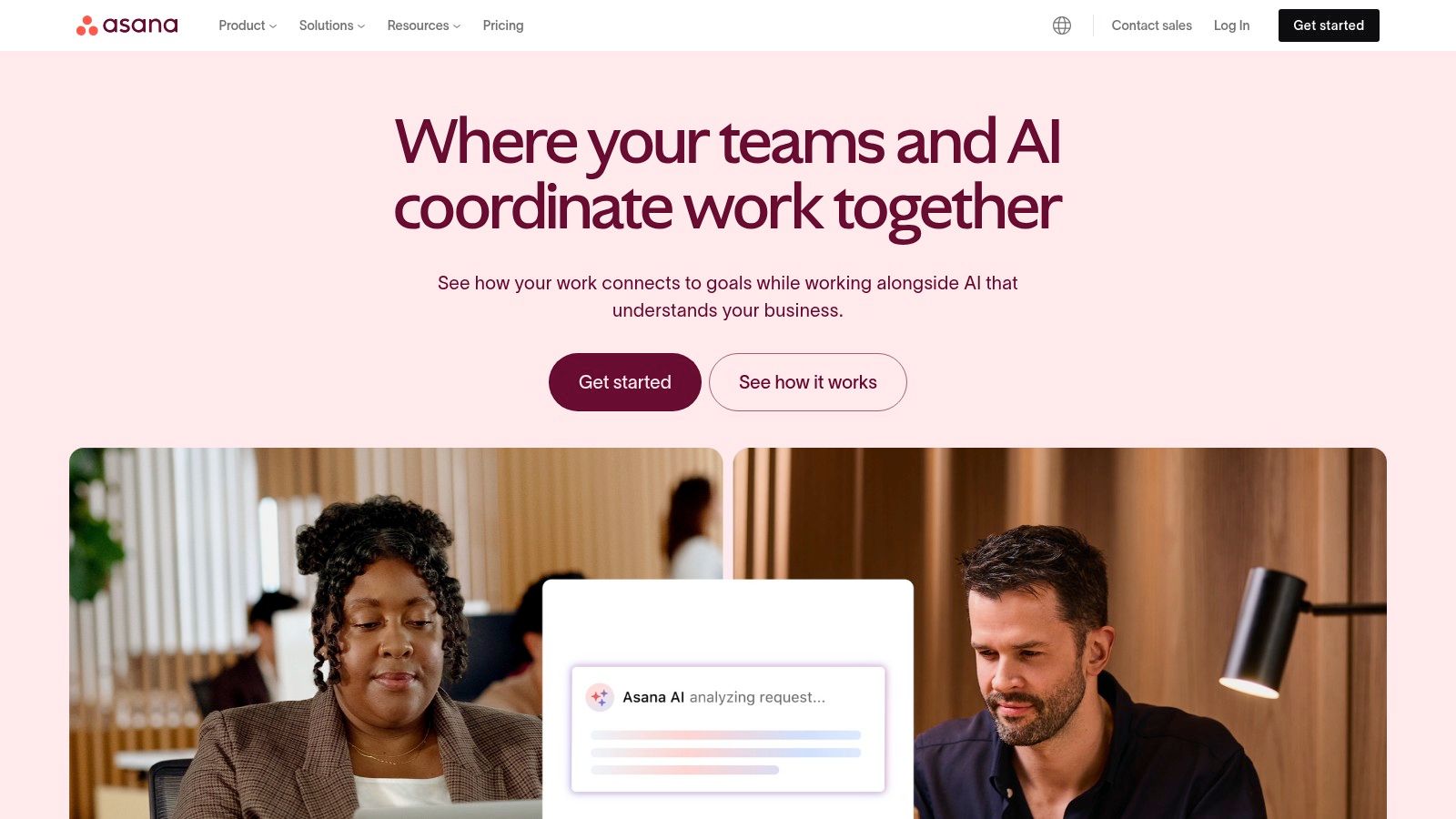
Key Features & Use Cases
Multiple Project Views: Switch between List, Board, Calendar, and Timeline views to visualize work in the way that best suits the project. This is perfect for teams with diverse roles, allowing each member to use their preferred workflow.
Workflow Automation: Use Rules to automate routine tasks, such as assigning new tasks to specific team members or moving completed tasks to a different section. This saves significant time on administrative overhead.
Robust Integrations: Asana connects with over 100 popular apps, including Slack, Google Drive, and Microsoft Teams, creating a centralized hub for all project-related communication and files.
Obsibrain Use Case: A research team can use Obsibrain for deep literature reviews and data analysis, keeping all interconnected notes in their private vault. For the collaborative publication phase, they can use Asana to manage the writing and review process, creating tasks for drafting sections, peer review, and journal submission, with each task linking back to the relevant research notes in Obsidian.
Pricing and Limitations
Asana offers a comprehensive Free plan for up to 15 users, which is a major advantage for startups and small businesses. However, for features like the Timeline view, custom fields, and advanced reporting, you'll need to upgrade. The Premium plan starts at $10.99 per user/month (billed annually).
While powerful, Asana can feel like overkill for teams with extremely simple to-do lists. The sheer number of features might be overwhelming for those who just need a basic task tracker without the project management overhead.
Website: https://asana.com
3. Trello
Trello champions simplicity and visual workflow management, making it one of the most approachable project management tools for small teams. Its entire philosophy is built around the Kanban method, using boards, lists, and cards to represent projects, stages, and tasks. This drag-and-drop system provides an at-a-glance overview of who is working on what and where each task stands in the workflow, from "To Do" to "Done."
The platform's strength lies in its intuitive nature; a new team can set up a project board and start collaborating in minutes. This makes it perfect for teams that don't need the complexity of Gantt charts or intricate dependency management. For a creative agency, a board could visualize the entire content production pipeline, while a small startup could use it to track customer feedback and feature requests, all with minimal setup.
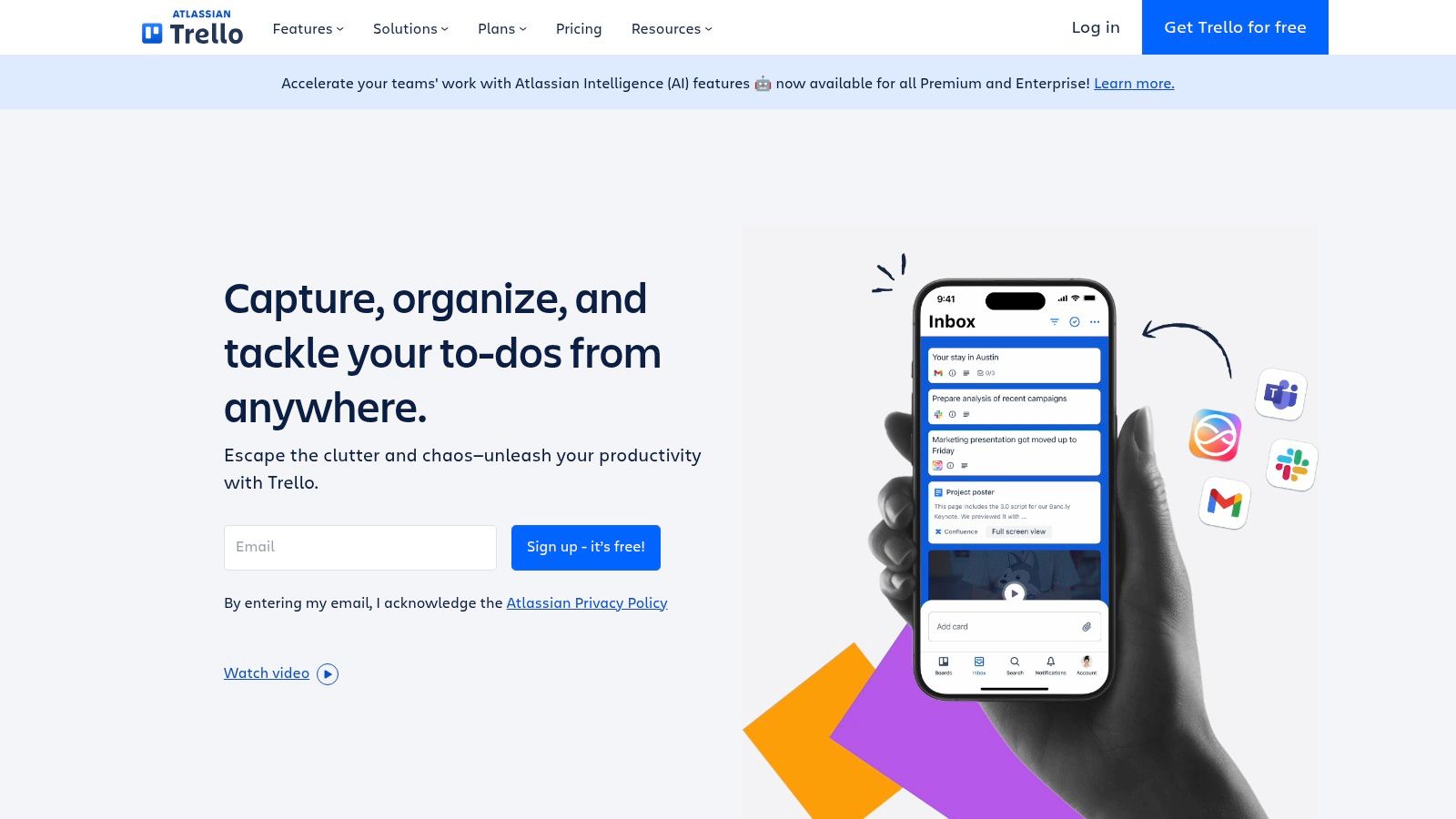
Key Features & Use Cases
Kanban-Style Boards: The core of Trello is its highly visual and flexible board system. Users can drag and drop cards between lists to show progress, which is ideal for managing linear workflows like event planning or sales funnels.
Power-Ups: Enhance board functionality by adding integrations and features like custom fields, calendar views, or connections to Slack and Google Drive. These "Power-Ups" allow teams to customize their workspace without overwhelming it.
Simple Collaboration: Each card acts as a mini-hub for a task, containing checklists, attachments, comments, and due dates, keeping all relevant information in one place.
Obsibrain Use Case: A consultant using Obsibrain for client discovery and strategy development can use Trello to create a shared project board with the client. The consultant can transfer high-level tasks from their detailed Obsibrain notes to Trello cards, allowing the client to visually track progress and provide feedback without accessing the consultant's private, in-depth research and analysis.
Pricing and Limitations
Trello’s Free plan is exceptionally generous, offering unlimited cards, up to 10 boards per workspace, and unlimited Power-Ups, making it a fantastic starting point. For more advanced features like different views (Calendar, Timeline, Map) and advanced automations, you'll need a paid plan. The Standard plan starts at $5 per user/month (billed annually).
While excellent for straightforward projects, Trello's simplicity can be a limitation. It lacks the built-in reporting and analytics tools found in more complex platforms, and managing multiple, intricate projects can make boards feel cluttered and difficult to navigate.
Website: https://trello.com
4. ClickUp
ClickUp positions itself as the "one app to replace them all," and for many small teams, it comes impressively close. It's a highly ambitious platform that consolidates tasks, documents, chat, goals, and more into a single, unified workspace. This makes it one of the most powerful project management tools for small teams that want to avoid juggling multiple subscriptions and tools. Its core strength lies in its extreme customizability, allowing teams to build workflows that are perfectly tailored to their specific processes, from simple to-do lists to complex, multi-stage projects.
What makes ClickUp truly unique is its all-in-one approach combined with a remarkably generous free tier. A small team can manage projects, create internal documentation, track time, and set goals without paying anything. For example, a creative agency could use its Board view for a Kanban workflow, the Docs feature for client briefs, and Goal tracking for quarterly revenue targets, all within the same platform.
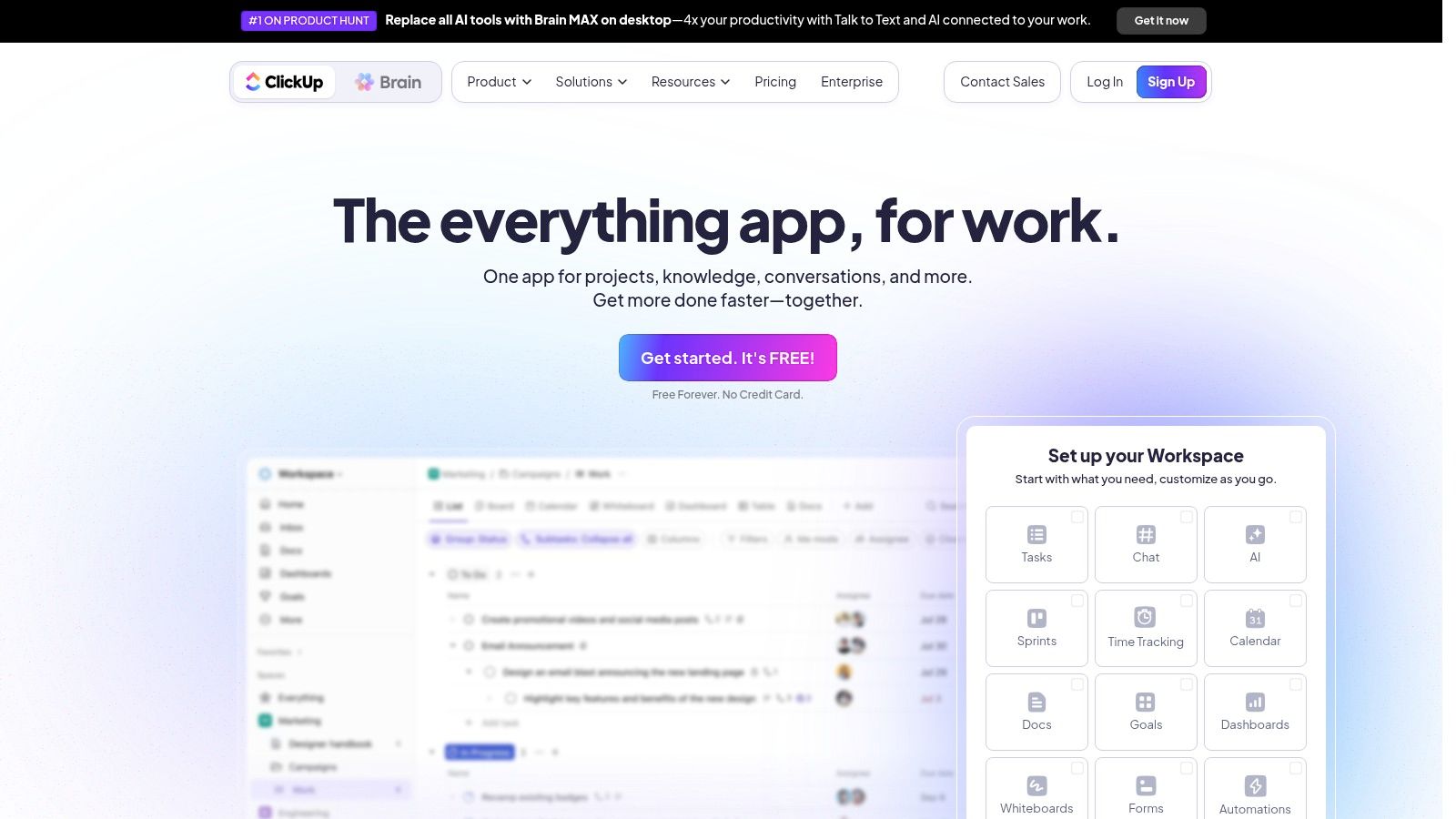
Key Features & Use Cases
Extreme Customization: Create custom statuses, fields, and views to match any workflow. This is ideal for specialized teams that don't fit into standard project management templates.
Built-in Docs & Whiteboards: Collaborate on documents and brainstorm ideas visually directly within your project space, eliminating the need for separate apps like Google Docs or Miro.
Comprehensive Task Management: Features include nested subtasks, checklists, task dependencies, and priorities, providing granular control over every aspect of a project.
Obsibrain Use Case: An academic researcher can use Obsibrain to build a comprehensive knowledge base, linking concepts, sources, and experimental data. For a specific research paper, they can create a project in ClickUp, using custom fields to track submission deadlines, journal requirements, and reviewer feedback. This keeps the logistical tasks in ClickUp while the core intellectual work remains interconnected within the private Obsibrain vault.
Pricing and Limitations
ClickUp’s Free Forever plan is one of the best on the market, offering unlimited tasks and members. However, for features like unlimited storage, Gantt charts, and advanced permissions, you'll need a paid plan. The Unlimited plan starts at $7 per user/month (billed annually).
The biggest challenge with ClickUp is its steep learning curve. The sheer volume of features and customization options can be overwhelming for new users, and the interface can sometimes feel cluttered. Teams looking for a simple, plug-and-play solution might find it to be too much.
Website: https://clickup.com
5. Monday.com
Monday.com positions itself as a "Work OS," a highly visual and customizable platform that empowers teams to build their own workflows from the ground up. It stands out among project management tools for small teams due to its colorful, intuitive interface and incredible flexibility. Instead of forcing teams into a rigid structure, Monday.com provides building blocks, like columns and views, that can be assembled to manage anything from a content pipeline to a product launch.
This adaptability makes it a powerful choice for teams with unique processes that don't fit into a standard project management model. A small creative agency, for example, can design a board to track client projects from proposal to final delivery, complete with columns for budget, client feedback, and creative assets, all in one clear, visual space. The platform's emphasis on visual tracking makes it easy to see project status at a glance.
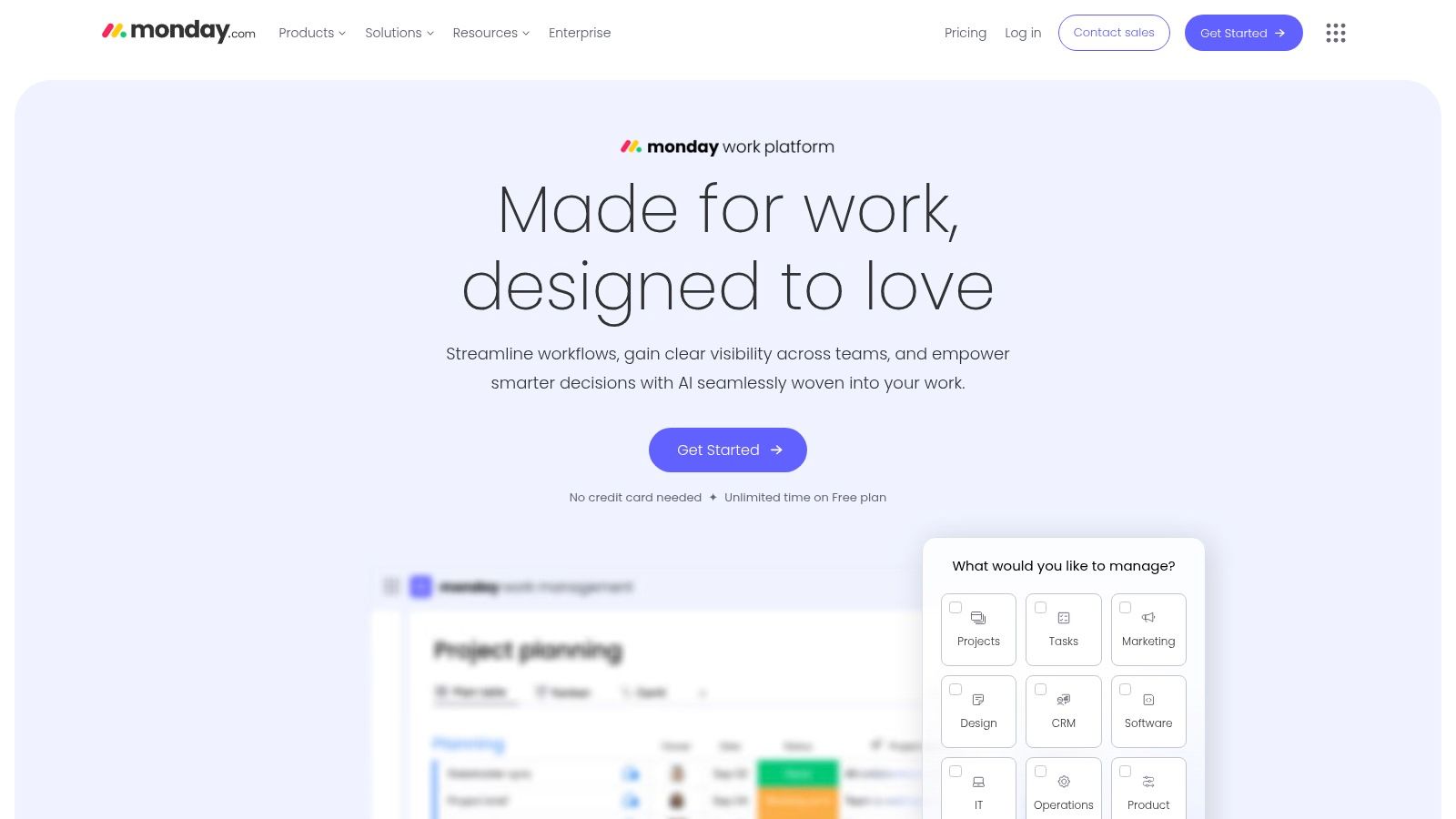
Key Features & Use Cases
Highly Customizable Workflows: Build boards from scratch or use one of hundreds of templates. Customize columns to track anything: text, numbers, statuses, people, dates, and more. This is ideal for teams that need to manage very specific data points for each task.
Multiple Data Views: Instantly switch between different views of your data, including Kanban, Calendar, Gantt (Timeline), and Chart views, without reconfiguring anything.
Powerful Automation: Automate repetitive work with simple "if this, then that" recipes. For instance, you can automatically notify a manager when a task's status changes to "Done" or create a new task when an email is received.
Obsibrain Use Case: A startup founder can use Obsibrain to develop their business plan, investor pitches, and product roadmap, maintaining a private repository of strategic thinking. They can then use Monday.com to create a high-level visual roadmap for the team, track fundraising activities with custom status columns, and manage the product development pipeline, turning strategic notes from Obsibrain into actionable, visual workflows.
Pricing and Limitations
Monday.com offers a very limited Free plan for up to 2 users, which is more of a trial than a functional team solution. The Basic plan starts at $8 per seat/month (billed annually, with a 3-seat minimum), but lacks key features like Timeline and Calendar views. The most popular Standard plan, which includes those views and automation, starts at $10 per seat/month.
The main drawback is its pricing model, which can quickly become expensive for small but growing teams due to the per-seat cost and minimum seat requirements. The sheer number of customization options can also be daunting for teams seeking a simple, out-of-the-box solution.
Website: https://monday.com
6. Zoho Projects
Zoho Projects is a powerful, cloud-based solution that stands out for teams already invested in or considering the broader Zoho ecosystem. It offers a comprehensive suite of tools designed to handle everything from simple tasks to complex, multi-stage projects. This platform is one of the best project management tools for small teams looking for an all-in-one solution that scales effectively without a prohibitive price tag.
Its main advantage is its seamless integration with other Zoho applications like Zoho CRM, Zoho Books, and Zoho Desk. This creates a unified business operating system where project data flows effortlessly between sales, finance, and support. For a small business managing client work, this means converting a deal in the CRM into a new project with all relevant details automatically, saving significant administrative time and reducing manual errors.
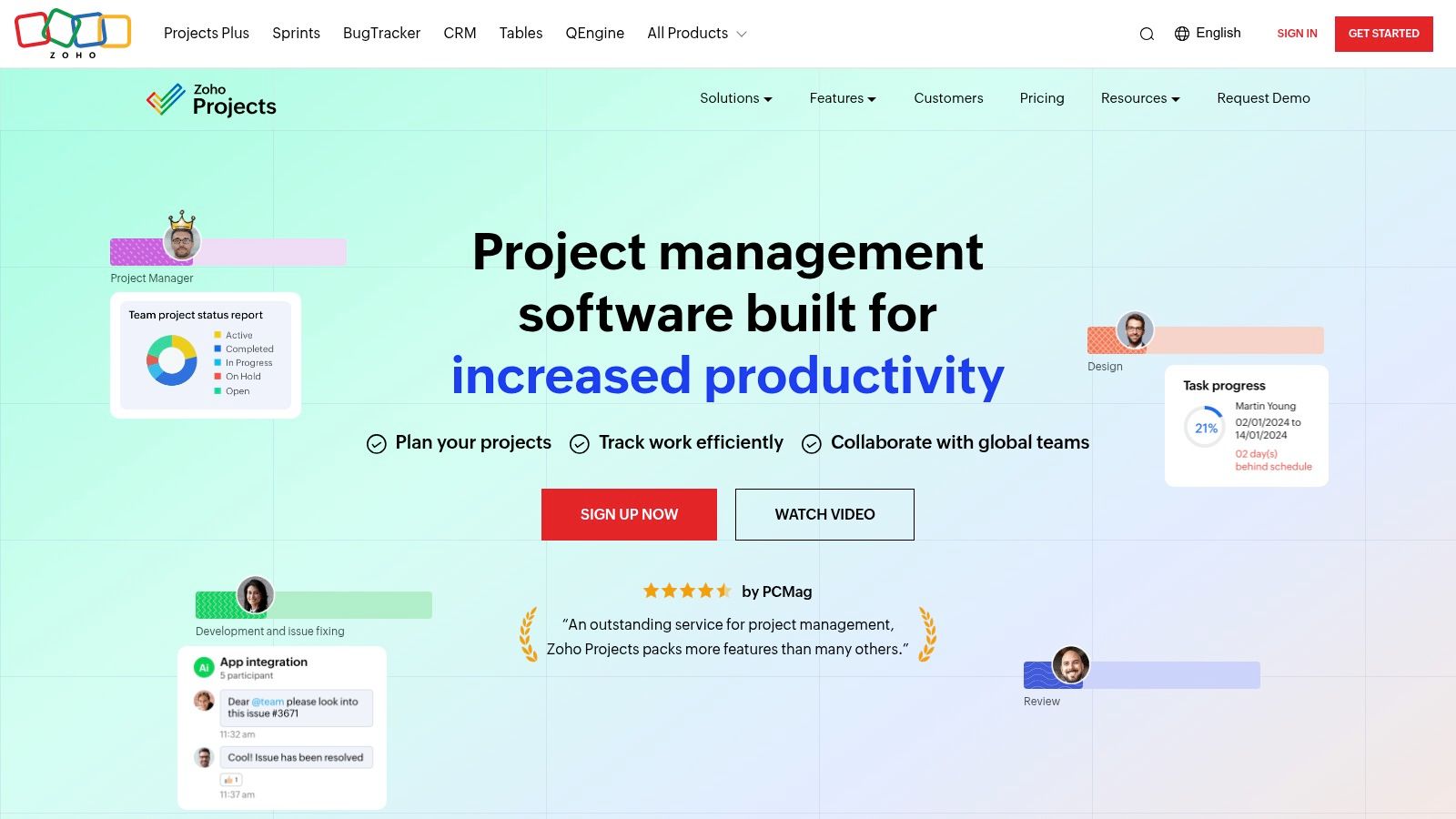
Key Features & Use Cases
Gantt Charts & Dependencies: Plan and visualize project timelines with interactive Gantt charts. Set task dependencies to ensure work progresses in the correct order, which is crucial for development or event planning projects.
Time Tracking and Billing: Built-in timesheets allow team members to log hours against specific tasks. This data can be used to generate invoices directly, streamlining the client billing process.
Issue Tracking & Automation: A dedicated module for tracking bugs and issues helps teams resolve problems efficiently. Use Blueprint to automate workflows, standardizing processes and ensuring compliance.
Obsibrain Use Case: A small business owner can use Obsibrain's client and meeting management features to capture all initial discussions and project requirements. Once the project is approved, they create a corresponding project in Zoho Projects to manage execution, track billable hours, and send invoices, using Zoho for the operational side while keeping the foundational client relationship knowledge organized in Obsibrain.
Pricing and Limitations
Zoho Projects offers an excellent Free plan for up to 3 users and 2 projects. Its paid plans are highly competitive, with the Premium plan starting at a very affordable $4 per user/month (billed annually).
The primary limitation is that its interface can feel slightly dated compared to more modern competitors, which might affect user adoption. While it integrates perfectly within its own ecosystem, the library of third-party integrations is less extensive than that of platforms like Asana or Trello.
Website: https://www.zoho.com/projects/
7. Teamwork
Teamwork is an exceptional choice among project management tools for small teams, particularly for agencies, consultancies, or any group that manages client work. It is built from the ground up to handle project delivery with a strong focus on profitability, time tracking, and client collaboration. The platform ensures that every project stays on schedule and within budget, making it invaluable for service-based businesses needing to maintain high levels of client satisfaction.
Its user-friendly interface simplifies complex project management, allowing teams to manage tasks, track time, and send invoices all from one place. What makes Teamwork stand out is its comprehensive feature set geared towards client-facing projects, including robust billing and invoicing capabilities that integrate directly with project tasks. This focus on the entire client work lifecycle, from initial quote to final payment, distinguishes it from more general-purpose tools.
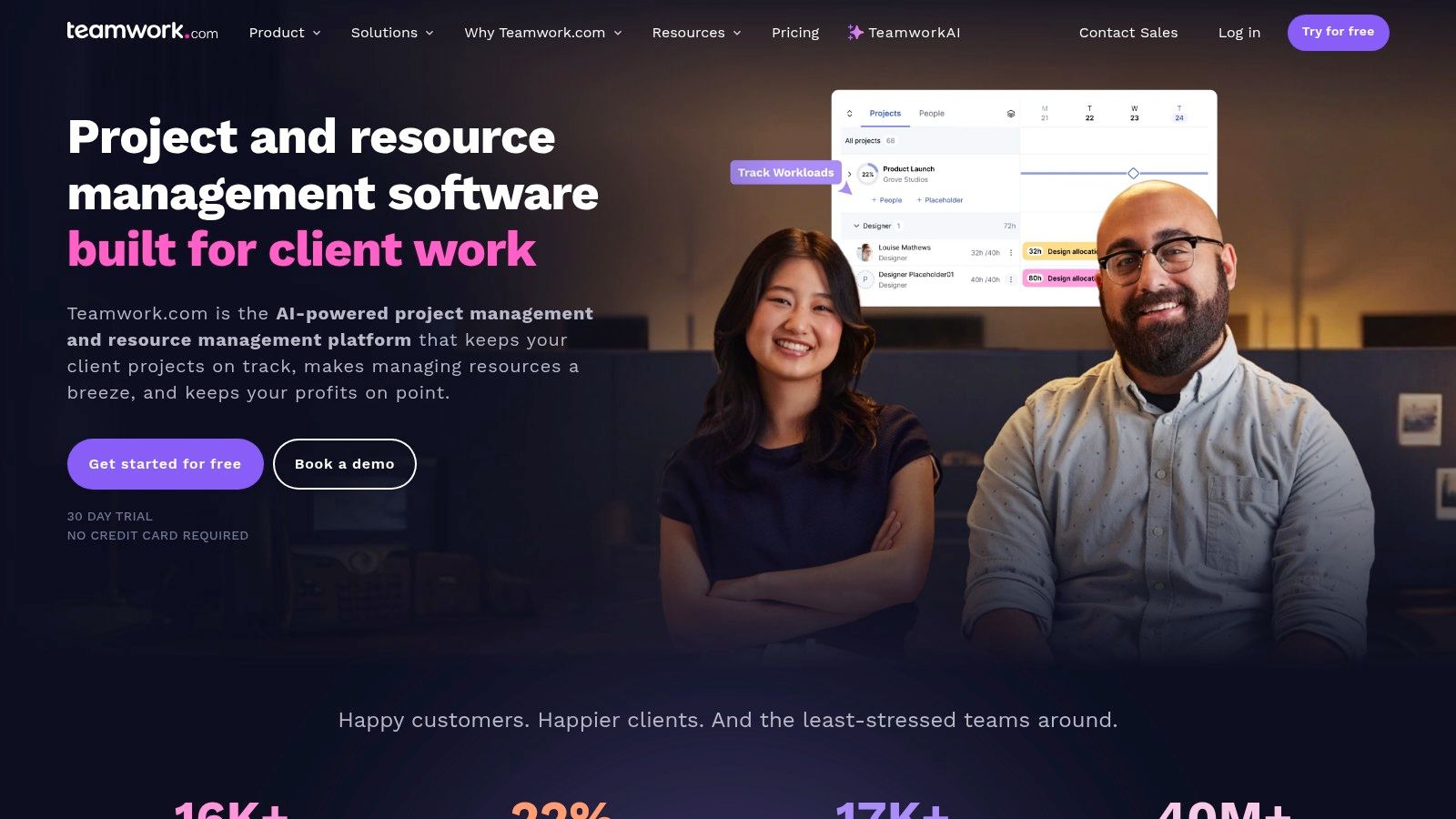
Key Features & Use Cases
Time Tracking and Billing: Log billable and non-billable hours directly on tasks. This data can then be used to create detailed invoices, providing full transparency for clients and ensuring accurate billing.
Gantt Charts and Milestones: Visualize project timelines, dependencies, and critical paths with interactive Gantt charts. Set key milestones to track major project deliverables and keep stakeholders informed.
Integrated Collaboration Tools: Communicate with your team and clients using built-in messages, file sharing, and notebooks, keeping all project-related discussions centralized and easy to find.
Obsibrain Use Case: An independent consultant can use Obsibrain’s integrated client management templates to detail project scopes, track meeting notes, and manage all client-related information. They can then use Teamwork for execution, setting up the project, tracking billable hours against specific tasks, and managing client communication, ensuring a seamless flow from initial client strategy in Obsibrain to final project delivery and invoicing in Teamwork. This aligns well with Obsibrain's CRM features.
Pricing and Limitations
Teamwork provides a generous Free Forever plan for up to 5 users, which includes core project and task management features. For growing teams needing more power, the Deliver plan starts at $9.99 per user/month (billed annually) and unlocks features like time tracking and invoicing.
The platform's main limitation can be its template library, which is less extensive than some competitors. While powerful for client work, teams looking for a simple internal task manager might find the client-focused features add unnecessary complexity.
Website: https://www.teamwork.com/
8. Wrike
Wrike positions itself as a powerful and scalable project management tool for small teams that have an eye on future growth. It provides a robust framework for managing complex projects with deep-level task organization, detailed reporting, and extensive customization options. This platform is particularly suited for teams that require granular control over their workflows and need to manage resource allocation effectively across multiple initiatives.
What sets Wrike apart is its enterprise-grade functionality packaged for smaller teams, including advanced analytics and AI-powered features even in accessible plans. For example, its workload management view gives managers a clear, visual representation of each team member's capacity, preventing burnout and ensuring balanced task distribution. This level of detail makes it a go-to for agencies, marketing teams, and professional services that bill for their time and need precise project tracking.
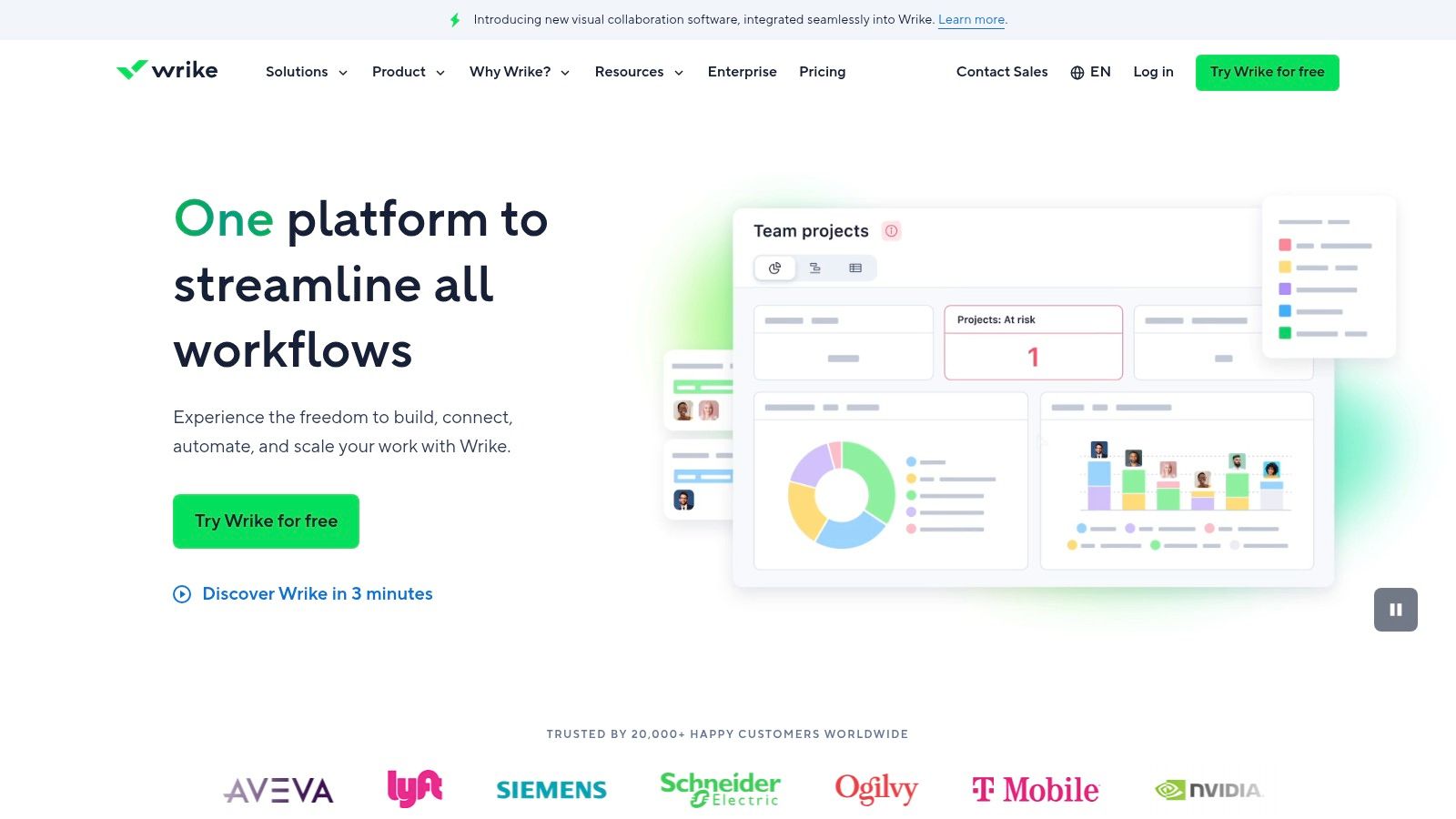
Key Features & Use Cases
Customizable Dashboards and Workflows: Build unique dashboards with widgets that display the most relevant project data, and create custom request forms to standardize intake processes.
Time Tracking and Workload Management: Native time tracking and visual workload charts help teams monitor effort, manage resources, and ensure projects stay on schedule and within budget.
Advanced Reporting and Analytics: Generate detailed performance reports to gain insights into project progress, team productivity, and potential bottlenecks, enabling data-driven decision-making.
Obsibrain Use Case: A marketing manager can use Obsibrain to outline campaign strategies, brainstorm creative concepts, and link market research notes. They can then use Wrike to translate this strategy into a detailed project plan, leveraging its resource management tools to assign tasks based on team capacity and using its custom dashboards to report on campaign ROI to stakeholders, connecting high-level strategy from Obsibrain to data-driven execution in Wrike.
Pricing and Limitations
Wrike offers a generous Free plan with core task management features for unlimited users. However, for more advanced capabilities, teams will need to upgrade. The Team plan starts at $9.80 per user/month and adds shareable dashboards and integrations. A key limitation is that time tracking is only available on the Business plan or higher. The interface can also present a steeper learning curve for teams accustomed to simpler tools.
Website: https://www.wrike.com/
9. Smartsheet
Smartsheet takes a unique approach to project management by leveraging the familiar structure of a spreadsheet and supercharging it with powerful automation, collaboration, and reporting capabilities. For teams that live and breathe data-heavy workflows and are comfortable in an Excel or Google Sheets environment, Smartsheet is one of the most robust project management tools for small teams available. It provides the granular control of a spreadsheet while adding the dynamic project views needed for modern workflows.
This platform shines when projects involve complex data tracking, budget management, or resource allocation. It transforms static grids into dynamic work hubs where tasks can be updated, files attached, and progress visualized through Gantt charts or card views. The learning curve can be steeper for those not accustomed to spreadsheets, but its power lies in its scalability and deep integration ecosystem.

Key Features & Use Cases
Multiple Views: Seamlessly switch between Grid, Gantt, Card, and Calendar views to manage work from different perspectives. This is ideal for tracking project timelines and dependencies with precision.
Powerful Automation: Automate repetitive processes like sending update requests, approving reports, or moving rows based on specific triggers, freeing up valuable team time.
Rich Integrations: Smartsheet connects deeply with essential business tools, including Microsoft 365, Google Workspace, Slack, and Salesforce, ensuring data flows smoothly across your tech stack.
Obsibrain Use Case: A financial analyst can use Obsibrain to take detailed notes on market trends and company performance. They can then use Smartsheet to manage a portfolio of projects, tracking budgets, resource allocation, and ROI with complex formulas and automated reporting. This allows for deep, qualitative analysis in Obsibrain to inform the quantitative, data-driven project management happening in Smartsheet.
Pricing and Limitations
Smartsheet offers a limited Free plan suitable for a single user with up to two sheets. For team collaboration, you'll need a paid plan. The Pro plan starts at $7 per user/month (billed annually) and unlocks most core features for teams of up to 10 users.
The primary limitation is its spreadsheet-centric design, which can feel less intuitive for creative or visually-oriented teams accustomed to drag-and-drop board interfaces. Its free offering is also significantly more restrictive compared to many competitors.
Website: https://www.smartsheet.com
10. Basecamp
Basecamp is one of the original and most enduring project management tools for small teams, championing simplicity and clarity over feature overload. Its core philosophy is to provide one central, organized place for everything a team needs to get work done. Instead of scattering discussions across email, files in Dropbox, and tasks in another app, Basecamp brings it all together under a single roof, reducing complexity and administrative friction.
The platform is built around the concept of individual projects, each containing a self-sufficient toolkit for communication and management. This all-in-one approach is particularly effective for teams who need to collaborate closely with clients, as Basecamp offers a straightforward way to grant them access to specific project areas. Its streamlined, no-frills interface ensures that everyone, regardless of technical skill, can participate without a steep learning curve.

Key Features & Use Cases
Unified Project Spaces: Each project has its own dedicated space with a message board, to-do lists, a schedule, and file storage. This keeps all relevant conversations and assets neatly contained.
Automatic Check-ins: Schedule recurring questions (e.g., "What did you work on today?") to replace status meetings, keeping everyone in the loop without disrupting their flow.
Client Access: Easily share progress with clients by giving them limited access to specific projects, allowing them to see to-do lists and join discussions, which streamlines feedback and approval cycles.
Obsibrain Use Case: A solo creator or small team can use Obsibrain to develop course content, scripts, and production notes in a private, interconnected knowledge system. They can then use Basecamp to collaborate with external partners—like video editors or designers—by creating a project space to share files, assign to-do lists, and manage feedback, keeping the core intellectual property secure in Obsibrain while facilitating communication in Basecamp.
Pricing and Limitations
Basecamp's pricing is unique and highly appealing for growing teams. The Pro Unlimited plan is a flat $299/month (billed annually) for unlimited users, projects, and clients, making it incredibly cost-effective as you scale. For individuals and smaller teams, there is a limited Free plan for up to 20 users and 3 projects.
However, its strength in simplicity is also its main limitation. Basecamp deliberately avoids advanced features like Gantt charts, time tracking, or complex reporting. Teams that require granular, data-heavy project analysis or follow strict agile methodologies might find it too basic for their needs.
Website: https://basecamp.com/
11. Notion
Notion has carved out a unique space as an all-in-one workspace, going beyond traditional project management tools for small teams by integrating notes, documents, wikis, and databases into a single, cohesive environment. Its core strength lies in its unparalleled flexibility. Instead of forcing teams into a predefined structure, Notion provides the building blocks-like pages, databases, and blocks-to create a completely customized system that mirrors a team's exact workflow.
This "Lego-like" approach makes it incredibly powerful for teams that need to connect high-level strategy documents, meeting notes, and granular tasks in one place. For example, a product team can house their entire product roadmap, user research notes, and sprint backlog within a unified Notion workspace, eliminating the need to jump between multiple applications. The platform's clean aesthetic and collaborative features make it a favorite among creative and tech-savvy teams.
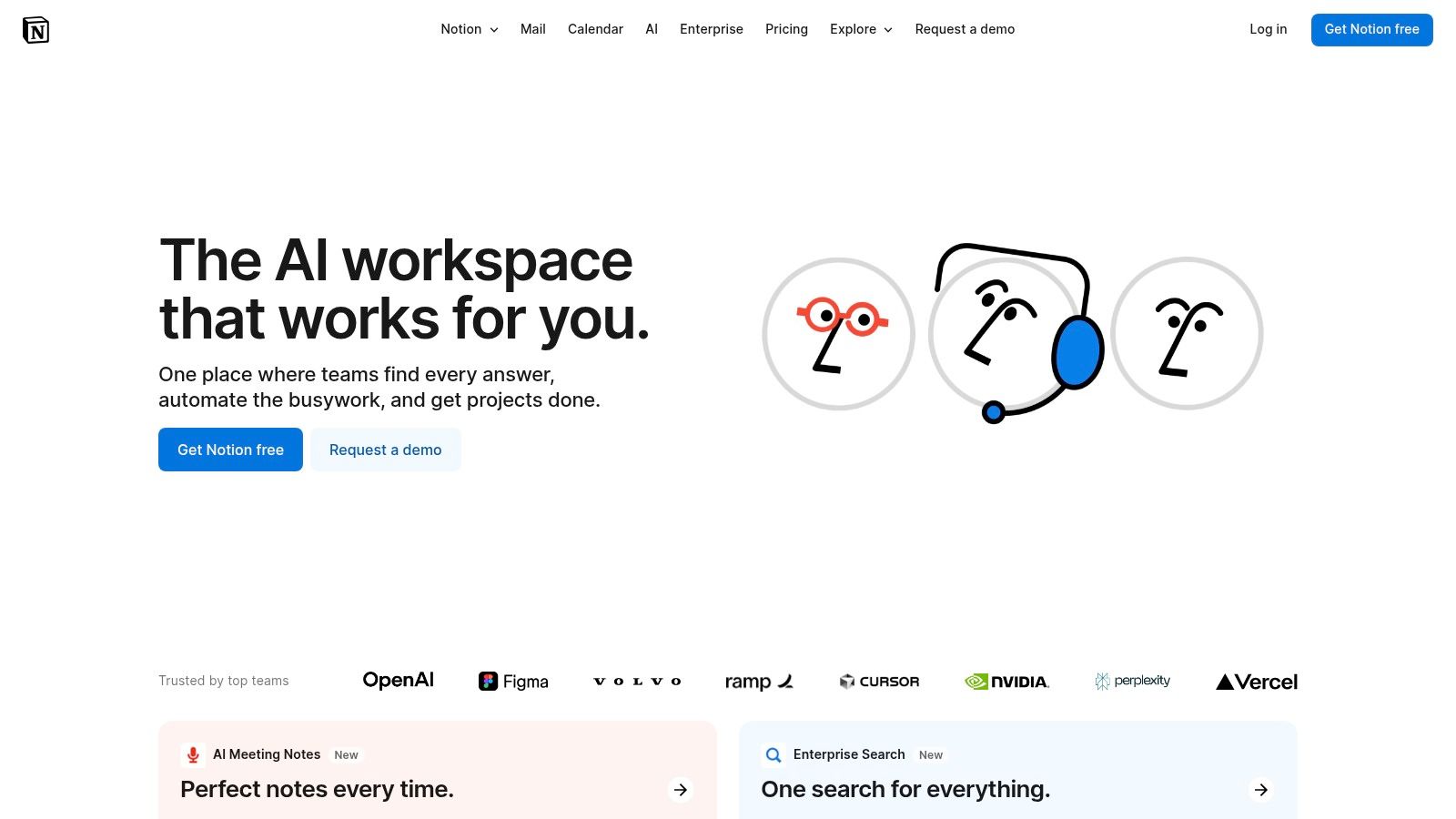
Key Features & Use Cases
Customizable Databases: Create powerful databases with different views (Table, Board, Calendar, List, Gallery, Timeline) to track projects, tasks, or anything else. This is ideal for managing everything from a content calendar to a CRM.
Linked Content & Backlinks: Easily link pages together to create an internal knowledge base or wiki, connecting project briefs directly to the tasks they generate.
Rich Text Editing: Pages are more than just task lists; they support rich media, embeds, code blocks, and complex layouts, making them perfect for documentation and creative briefs.
Obsibrain Use Case: While both tools are strong in knowledge management, a user can leverage their unique strengths. Obsibrain can serve as the private, offline-first "second brain" for deep, unstructured thinking and idea connection. The most refined ideas and structured plans can then be moved to a shared Notion workspace for team collaboration, leveraging Notion's superior presentation and real-time collaborative editing features for team-facing documents and project boards. Learn more about structuring your plans with Obsibrain.
Pricing and Limitations
Notion offers a generous Free plan with collaborative workspaces and a solid feature set for individuals and very small teams. The Plus plan, starting at $8 per user/month (billed annually), unlocks more features for small teams.
The primary drawback is its steep learning curve; the sheer customizability can be overwhelming for new users. It also relies heavily on an internet connection, as its offline functionality is limited, which can be a problem for users who need to work on the go without reliable access.
Website: https://www.notion.so/
12. Nifty
Nifty positions itself as a powerful, all-in-one workspace designed to consolidate project management workflows. For small teams tired of switching between different apps for tasks, documents, and communication, Nifty offers a unified solution. It excels at providing a clear, high-level overview of project timelines through its Milestones feature, while still allowing for granular task management. This makes it one of the most cohesive project management tools for small teams looking to streamline their tool stack.
The platform's strength lies in its ability to centralize core project activities. A team can plan a project roadmap, create and assign dependent tasks, collaborate on project documents in real-time, and track billable hours without ever leaving the application. This integrated approach reduces context switching and keeps the entire team aligned and focused on project goals from a single source of truth.
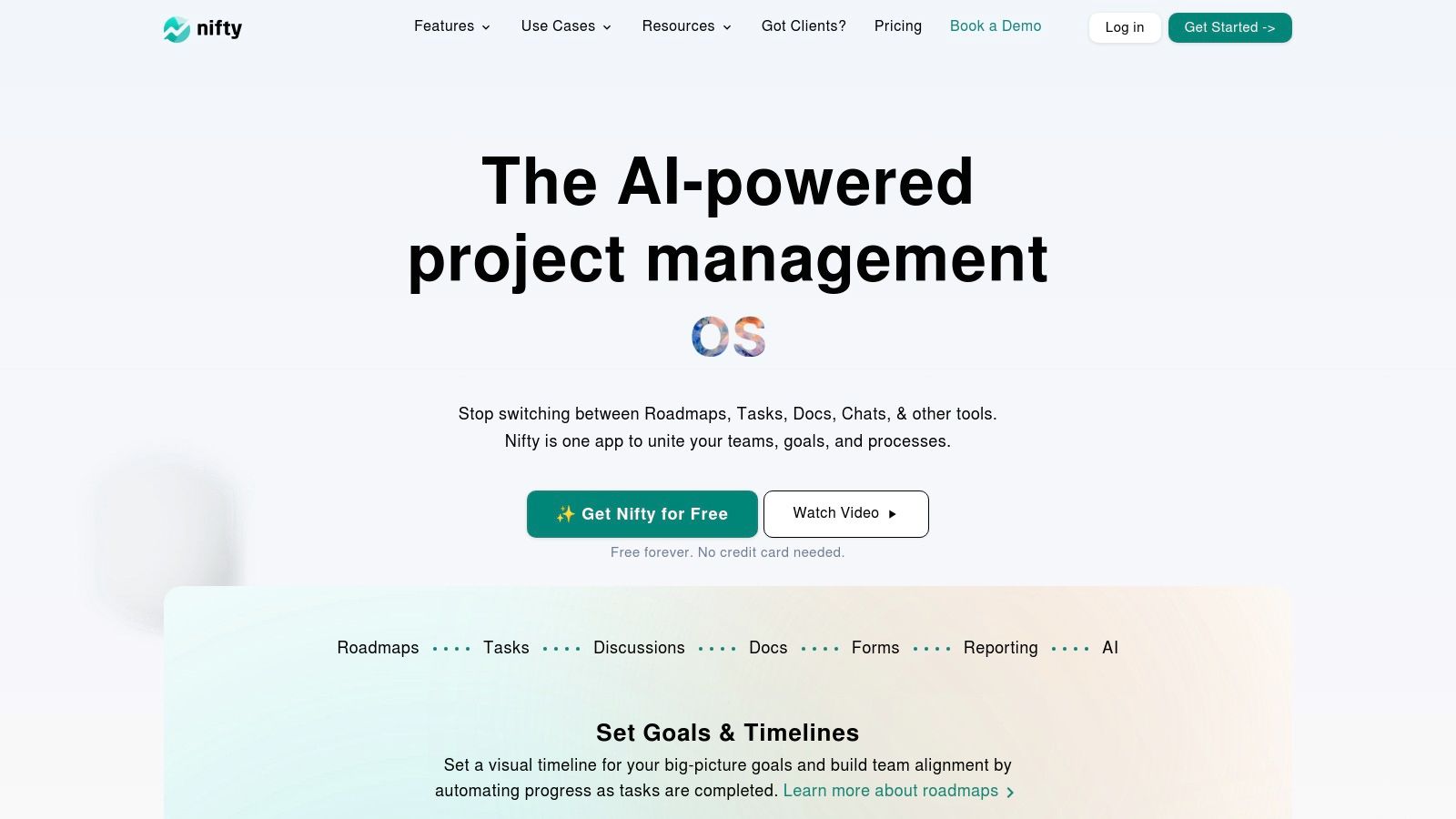
Key Features & Use Cases
Milestones (Gantt Charts): Visually plan and track project progress against key deadlines. This is ideal for client-facing projects where demonstrating progress against a timeline is crucial.
Built-in Docs & Files: Create, edit, and collaborate on documents and specifications directly within projects, linking them to specific tasks and milestones. This eliminates the need for a separate document management tool.
Time Tracking & Reporting: Native time tracking allows teams to monitor time spent on tasks, which is essential for accurate client billing, resource allocation, and budget management.
Obsibrain Use Case: A software development team lead can use Obsibrain to map out system architecture, document complex algorithms, and keep personal notes on team member performance. They can then use Nifty to manage the development sprints, using Milestones to track feature releases, creating tasks for bug fixes and new development, and using Nifty’s built-in docs for user-facing documentation, keeping the deep technical knowledge separate but accessible in Obsibrain.
Pricing and Limitations
Nifty offers a generous Free plan with unlimited users and tasks, making it highly accessible. For more advanced features, paid plans like Starter begin at a very competitive $5 per user/month. The Pro plan at $10 per user/month adds features like custom fields and time tracking.
The primary limitation is its smaller integration library compared to giants like Asana or ClickUp. While it covers the essentials like Slack and Google Drive, teams relying on more niche third-party tools may find it lacking. Additionally, some users report the mobile app experience is less robust than the desktop version.
Website: https://niftypm.com/
Project Management Tools Feature Comparison
🏆 Obsibrain
Task mgmt, habit tracking, P.A.R.A. system, SMART goals, client & meeting mgmt ✨
Mobile optimized, theme compatible, lifetime updates ★★★★☆
One-time $58 💰, saves hours daily, 30-day guarantee
👥 All Obsidian users, beginners to advanced
Science-backed, offline data ownership, unified all-in-one system ✨
Asana
Task assignments, multiple views, workflow automation
User-friendly ★★★★☆
Free plan up to 15 users 💰; premium required for advanced
👥 Small teams
Strong integrations, easy to start
Trello
Kanban boards, customizable cards, Power-Ups
Intuitive ★★★★☆
Generous free plan 💰
👥 Small teams
Simple visual project management
ClickUp
Multiple views, dashboards, time tracking
Customizable, comprehensive ★★★★☆
Free plan with many features 💰
👥 Small teams
All-in-one productivity platform
Monday.com
Custom workflows, multiple views, automation
Visual, user-friendly ★★★★
No free plan, premium priced 💰
👥 Teams needing customization
Strong automation and flexibility
Zoho Projects
Task dependencies, Gantt charts, time tracking
Functional but outdated ★★★
Affordable pricing 💰
👥 Small teams
Zoho ecosystem integration
Teamwork
Task lists, time tracking, milestones
User-friendly ★★★★
Free plan available 💰
👥 Client-focused teams
Client work management focus
Wrike
Dashboards, workflows, reporting, integrations
Robust but complex ★★★★
Free plan, paid tiers 💰
👥 Small teams seeking scalability
AI-powered features
Smartsheet
Grid/card views, automation, resource management
Spreadsheet-like ★★★★
Limited free plan 💰
👥 Excel users & growing teams
Strong automation & reporting
Basecamp
To-do lists, message boards, file sharing
Simple, centralized ★★★★
Flat-rate pricing 💰
👥 Larger teams needing simplicity
Flat-rate model, communication centered
Notion
Custom pages, databases, task mgmt
Highly flexible ★★★★
Affordable pricing 💰
👥 Small teams & creatives
Combines notes + tasks + dbs
Nifty
Milestones, dependencies, doc collaboration
User-friendly ★★★☆
Affordable pricing 💰
👥 Small teams
All-in-one with central collaboration
Final Thoughts
Navigating the vast landscape of project management tools for small teams can feel overwhelming, but it's a crucial step toward unlocking your team's full potential. Throughout this guide, we've explored a diverse range of platforms, from the visual simplicity of Trello to the all-in-one power of ClickUp and the spreadsheet-like strength of Smartsheet. Each tool offers a unique approach to organizing tasks, tracking progress, and fostering collaboration.
The key takeaway is that there is no single "best" solution; there is only the best solution for your team. The ideal tool is one that aligns seamlessly with your existing workflows, addresses your specific pain points, and fits within your budget. A creative agency that thrives on visual brainstorming will have vastly different needs than a software development team that requires intricate dependency tracking and sprint planning.
Choosing Your Path: A Final Decision Framework
As you move from evaluation to decision, distill your choice down to a few core factors. Resist the temptation of a tool with a thousand features if your team will only ever use ten. Instead, focus on the functionalities that will deliver the most immediate and significant impact on your daily operations.
To make your final selection, consider these critical questions:
Complexity vs. Simplicity: Does your team need a high-octane, feature-rich platform like Wrike or Zoho Projects, or would a more intuitive, straightforward tool like Trello or Basecamp reduce friction and encourage adoption? Overly complex systems are often underutilized.
Primary Workflow: What is the core activity you need to manage? Is it content production (Asana), client work (Teamwork), software development (ClickUp), or long-term strategic planning (Smartsheet)? Let your primary workflow guide your choice.
Integration Needs: How well does the tool connect with the software you already use every day, such as Slack, Google Drive, or GitHub? Poor integration can create more manual work, defeating the purpose of a project management tool.
Scalability: While you're a small team now, where do you see your projects and team size in one or two years? Choosing a tool like Monday.com or Notion provides a scalable foundation that can grow with you.
Beyond the Software: Implementation is Key
Remember, the tool itself is only half the equation. Successful implementation is what truly transforms a team’s productivity. Whichever platform you choose, dedicate time to proper onboarding. Host a kickoff session, establish clear guidelines for how the tool will be used, and create a few template projects to demonstrate best practices.
For teams leveraging knowledge management systems like Obsidian, the integration with your project management tool becomes a powerful nexus of productivity. Consider how a tool like Obsibrain can act as the connective tissue, linking project tasks in your chosen platform directly to your knowledge base. This allows goal-oriented individuals and academics to create a structured planning environment where project deliverables are directly supported by deep research, notes, and intellectual assets stored in their Obsidian vault.
Ultimately, the goal is to find a system that reduces administrative overhead and empowers your team to focus on what they do best. By carefully considering your unique needs and committing to a thoughtful implementation process, you can select one of the premier project management tools for small teams that will serve as a catalyst for growth, clarity, and success.
Ready to bridge the gap between your project tasks and your knowledge base? Discover how Obsibrain enhances your workflow by linking project planning with your personal knowledge management system, creating a powerful, unified command center for all your work. Explore the possibilities at Obsibrain.
Last updated
Was this helpful?